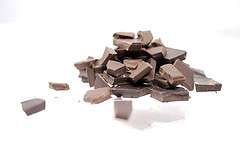Chocolate genome research good for farmers, environment, sweet lovers

(Phys.org)—With the help of information technology (IT), Penn State professor Mark Guiltinan makes the world a sweeter place.
Guiltinan is a professor of plant molecular biology in the Department of Horticulture in the College of Agricultural Sciences. He currently runs the Guiltinan Lab, where he studies crop improvement and sustainable farming methods. Guiltinan was a key player in The International Cocoa Genome Sequencing Consortium, a worldwide effort to sequence and analyze the genome of the Criollo variety of the Theobromo cacao plant, the key ingredient in high-quality chocolate. Using genome sequencing programs and computer clusters at Penn State and abroad, Guiltinan and his colleagues have mapped the cacao genome and are working to breed better, more disease-resistant cacao plants.
Despite the incredible popularity of chocolate, the cacao plant is surprisingly difficult to grow. About 70 percent of the world's chocolate comes from West Africa, where cacao farmers often live in poverty and operate small farms. The highest quality chocolate comes from the Criollo variety of the cocoa plant, a crop that is highly susceptible to disease. An outbreak of disease among these cacao plants can destroy the lives of the farmers and their local economies.
Unlike staple crops like corn and soy, cacao trees have not been researched extensively or engineered to resist disease, and many of these trees cannot yield enough cacao to meet the growing international demand for chocolate. Guiltinan and his colleagues' research aims to the study specific gene families of Criollo that relate to disease resistance. By understanding the cacao genome and ultimately breeding higher quality cacao trees, Guiltinan hopes to provide economic, social and environmental advantages for chocolate-producing nations.
"Understanding the chocolate genome will have so many benefits," Guiltinan explained. "Perennial tree crops like cacao are good for the soil. They protect the water shed and provide a habitat for insects, birds and other animals."
Guiltinan believes that improving the genetic makeup of the cacao plant is ultimately more beneficial than using pesticides, since cacao farmers are rarely able to afford pesticides or the equipment needed to administer them. Also, Guiltinan's genetic approach is more environmentally friendly.
"You can fight disease with chemicals, but genetics is really the best way to do it," Guiltinan said. "The technology is already in the DNA. You don't have to spray it on. It doesn't get washed off. You don't need spraying equipment. You don't need chemicals."
The incredible amount of research and data in Guiltinan's collection would not be possible without IT. In October 2009, Penn State researchers conducted a total of five genome sequencing runs using a computer sequencer called Roche/454 GS FLX. The sequencer is located on campus on the third floor of Wartik Laboratory. In order to use the sequencer, researchers loaded a sample of the DNA from the Criollo variety of the Theobromo cacao plant. The sequencer produced a series of image files, which then needed to be analyzed.
According to Guiltinan, sequencing the genome is not the most difficult aspect of his research. Rather, he believes the real challenge lies in analyzing the data and identifying which genes are most important in disease resistance.
"You need to be able to mine the data, filter it and extract the information out of the data in a meaningful way," Guiltinan stated.
A computer cluster on the fifth floor of Wartik Lab was responsible for the preliminary stages of analyzing the data. A computer cluster is a group of interconnected computers that work together as a singular, powerful machine. The computer cluster takes the image files produced by the sequencer and analyzes them to produce files listing DNA sequences.
Using the sequenced and analyzed data, Guiltinan utilized a database called Genome Browser (GBrowse), which allows genome sections to be viewed graphically and displays quantitative and qualitative data in a user-friendly format.
Once this process was complete, the data was then transferred to databases in Montpelier, France, where the majority of the project was completed.
With the help of computer technology, Guiltinan's research is making a profound impact on the world. The sequenced chocolate genome will not only lead to a greater supply of high-quality chocolate in the U.S., but farmers, their communities and environments will benefit as well.
"I believe in technology, and I believe that if we use it wisely, we can reach a sustainable society some day," Guiltinan said.
More information:
stream.it.psu.edu/issue/v1/i3
plantscience.psu.edu/research/labs/guiltinan
Provided by Pennsylvania State University


















